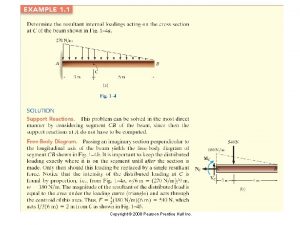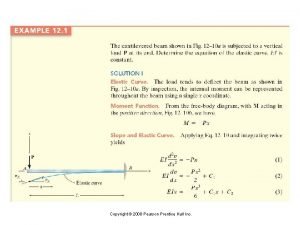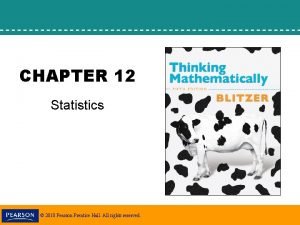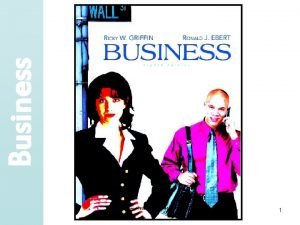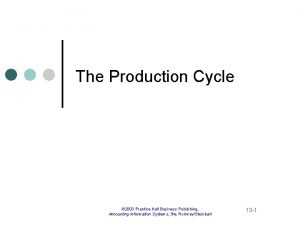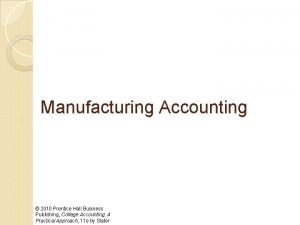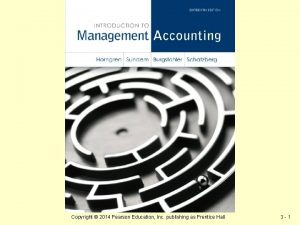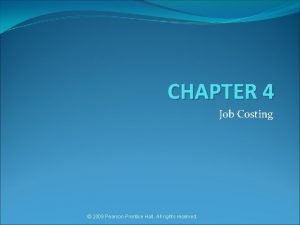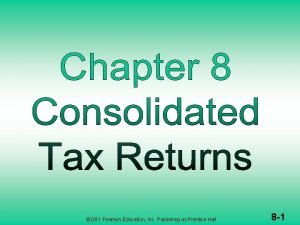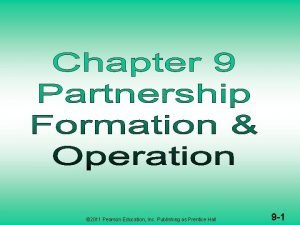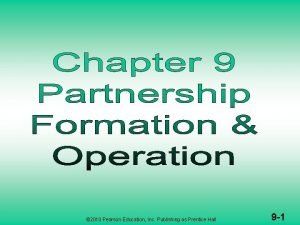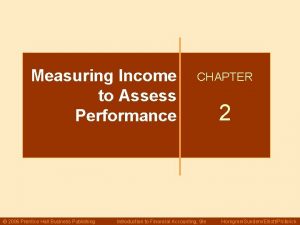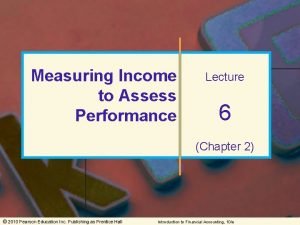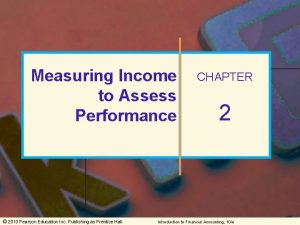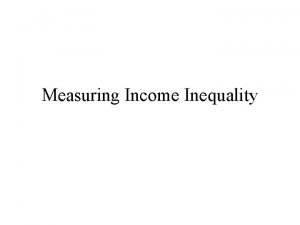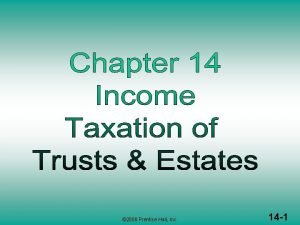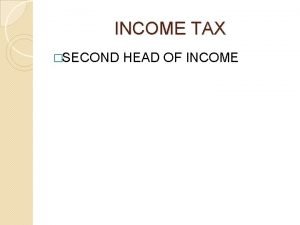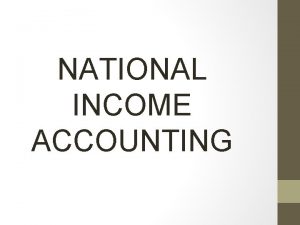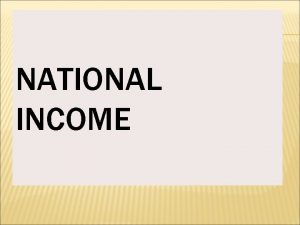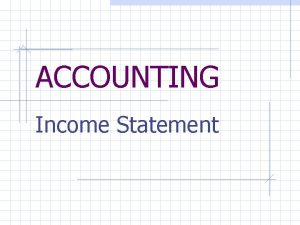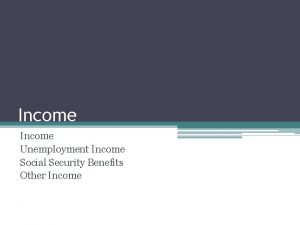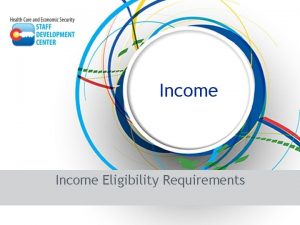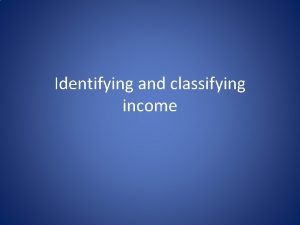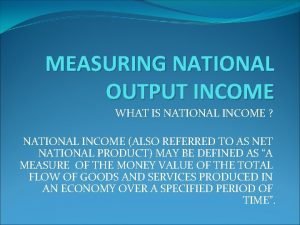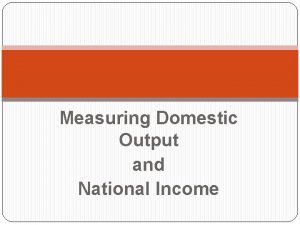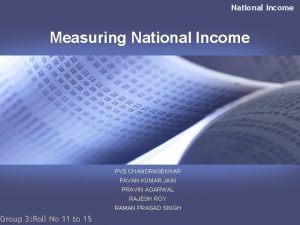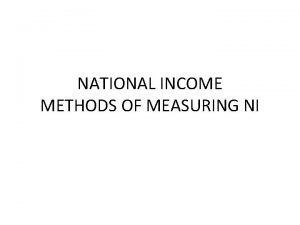Measuring Income to Assess Performance 2006 Prentice Hall

























- Slides: 25

Measuring Income to Assess Performance © 2006 Prentice Hall Business Publishing CHAPTER Introduction to Financial Accounting, 9/e 2 Horngren/Sundem/Elliott/Philbrick

INCOME and EXPENSES © 2006 Prentice Hall Business Publishing Introduction to Financial Accounting, 9/e Horngren/Sundem/Elliott/Philbrick 2 of 49

INCOME and EXPENSES LINKAGE q ENHANCE YOUR PREVIOUS KNOWLEDGE ABOUT FINANCIAL STATEMENTS- INCOME STATEMENT q YOU WILL BE ABLE TO PREPARE INCOME STATEMENT OF ANY BUSINESS © 2006 Prentice Hall Business Publishing Introduction to Financial Accounting, 9/e Horngren/Sundem/Elliott/Philbrick 3 of 43

OUTCOME of THIS SESSION ü What is Income Statement ü Elements of Income Statement ü Accrual vs Cash basis of Accounting ü Accrual and Matching concepts © 2006 Prentice Hall Business Publishing Introduction to Financial Accounting, 9/e Horngren/Sundem/Elliott/Philbrick 4 of 43

INCOME and EXPENSES STRUCTURE OF THIS SESSION 50: 50 § Active participation is sought PARTICIPATION MEANS v Contributing innovative and effective ideas towards the current topic v Answering various questions v Following the mentor’s instructions © 2006 Prentice Hall Business Publishing Introduction to Financial Accounting, 9/e Horngren/Sundem/Elliott/Philbrick 5 of 43

INCOME and EXPENSES WIIFM o THIS SESSION WILL HELP YOU TO OBTAIN BASIC UNDERSTANDING OF INCOME STATEMENT © 2006 Prentice Hall Business Publishing Introduction to Financial Accounting, 9/e Horngren/Sundem/Elliott/Philbrick 6 of 43

What is INCOME? • Some kind of INFLOW of economic benefit – Cash or accounts receivable TYPES OF INCOME § Sale of goods § Rendering of services § OTHERS § Interest § Royalties § Dividends © 2006 Prentice Hall Business Publishing Introduction to Financial Accounting, 9/e Horngren/Sundem/Elliott/Philbrick 7 of 49

Generation of INCOME • Income is generated primarily through the OPERATING CYCLE © 2006 Prentice Hall Business Publishing Introduction to Financial Accounting, 9/e Horngren/Sundem/Elliott/Philbrick 8 of 49

Operating Cycle Starts with Cash $100, 000 Buys Merchandise Inventory $100, 000 Sells Merchandise Accounts Receivable $160, 000 Collects Cash © 2006 Prentice Hall Business Publishing Introduction to Financial Accounting, 9/e Horngren/Sundem/Elliott/Philbrick 9 of 49

Effect of Income on Owners’ Equity q INCOME ALWAYS INCREASES OWNERS’ EQUITY © 2006 Prentice Hall Business Publishing Introduction to Financial Accounting, 9/e Horngren/Sundem/Elliott/Philbrick 10 of 49

WHAT IS EXPENSE? q Some kind of OUTFLOW of economic benefit – Cash or accounts payable q. Costs incurred to generate revenue q. Economic benefit WILL EXPIRE during a SINGLE PERIOD q. Salaries, utility bills, rent etc © 2006 Prentice Hall Business Publishing Introduction to Financial Accounting, 9/e Horngren/Sundem/Elliott/Philbrick 11 of 49

Effect of Expense of Owners’ Equity q ALWAYS DECREASES OWNERS’ EQUITY © 2006 Prentice Hall Business Publishing Introduction to Financial Accounting, 9/e Horngren/Sundem/Elliott/Philbrick 12 of 49

The Accounting Time Period • Companies measure their performance over discrete time periods • The calendar year is the most common time period for measuring income or profits • About 40% of large companies use a fiscal year that differs from a calendar year © 2006 Prentice Hall Business Publishing Introduction to Financial Accounting, 9/e Horngren/Sundem/Elliott/Philbrick 13 of 49

The Accounting Time Period • The fiscal year-end date is often the low point in annual activity when inventories can be counted more easily • Companies also prepare financial statements for interim periods • Interim periods may be for a month or a quarter (3 -month period) © 2006 Prentice Hall Business Publishing Introduction to Financial Accounting, 9/e Horngren/Sundem/Elliott/Philbrick 14 of 49

Revenues and Expenses • Revenues and expenses are the key inflows and outflows of assets that occur during a business’s operating cycle • Revenues are the amount of assets received in exchange for the delivery of goods or services to customers • Expenses are measures of the assets that a company gives up or consumes in order to deliver goods or services to a customer © 2006 Prentice Hall Business Publishing Introduction to Financial Accounting, 9/e Horngren/Sundem/Elliott/Philbrick 15 of 49

Revenues and Expenses • Income is the excess of revenues over expenses • Profits or earnings are common synonyms for income © 2006 Prentice Hall Business Publishing Introduction to Financial Accounting, 9/e Horngren/Sundem/Elliott/Philbrick 16 of 49

Revenues and Expenses • Accounts receivable are the amounts owed by customers as a result of delivering goods or services on account in the ordinary course of business • Cost of goods sold expense is the original acquisition cost of the inventory that a company sells to customers during the reporting period © 2006 Prentice Hall Business Publishing Introduction to Financial Accounting, 9/e Horngren/Sundem/Elliott/Philbrick 17 of 49

Accrual Basis and Cash Basis • The accrual basis recognizes the impact of transactions in the financial statements for the time periods when revenues and expenses occur • Accountants record revenue as a company EARNS it, and they record expenses as the company INCURS them © 2006 Prentice Hall Business Publishing Introduction to Financial Accounting, 9/e Horngren/Sundem/Elliott/Philbrick 18 of 49

Accrual Basis and Cash Basis • The cash basis recognizes the impact of transactions in the financial statements only when a company receives or pays cash • THE ACCRUAL BASIS IS THE BEST BASIS FOR MEASURING ECONOMIC PERFORMANCE © 2006 Prentice Hall Business Publishing Introduction to Financial Accounting, 9/e Horngren/Sundem/Elliott/Philbrick 19 of 49

Recognition of Revenues • Revenues are recognized when they – Are earned • A company earns revenues when it delivers goods or services to customers – AND are realized • A company realizes revenues when it receives cash or claims to cash in exchange for goods or services----Accounts Receivable © 2006 Prentice Hall Business Publishing Introduction to Financial Accounting, 9/e Horngren/Sundem/Elliott/Philbrick 20 of 49

Recognition of Expenses • Expenses are recognized when they are: – INCURRED • Paid ; or • Payable © 2006 Prentice Hall Business Publishing Introduction to Financial Accounting, 9/e Horngren/Sundem/Elliott/Philbrick 21 of 49

MATCHING CONCEPT • Record the expenses in the same period when the RELATED REVENUE has been recognized. – EXPENSES will be MATCHED WITH REVENUE © 2006 Prentice Hall Business Publishing Introduction to Financial Accounting, 9/e Horngren/Sundem/Elliott/Philbrick 22 of 49

Matching • There are two kinds of expenses in every accounting period: – Product costs are those linked with the revenues earned that period – Period costs are those linked with the time period itself • Matching occurs when the expenses incurred in a period are matched to the revenues generated in the same period © 2006 Prentice Hall Business Publishing Introduction to Financial Accounting, 9/e Horngren/Sundem/Elliott/Philbrick 23 of 49

Applying Matching • Depreciation is the systematic allocation of the acquisition cost of long-lived assets to the periods that benefit from the use of the assets • Land is not subject to depreciation because it does not deteriorate over time © 2006 Prentice Hall Business Publishing Introduction to Financial Accounting, 9/e Horngren/Sundem/Elliott/Philbrick 24 of 49

Applying Matching The following transaction records depreciation expense Assets = Liabilities + Owners’ Equity Store Equipment = Recognize depreciation expense © 2006 Prentice Hall Business Publishing -100 = Introduction to Financial Accounting, 9/e Retained Earnings -100 (increase depreciation expense) Horngren/Sundem/Elliott/Philbrick 25 of 49
 Pearson education inc publishing as pearson prentice hall
Pearson education inc publishing as pearson prentice hall Prentice hall inc
Prentice hall inc 2008 pearson prentice hall inc
2008 pearson prentice hall inc Copyright 2005 pearson prentice hall inc
Copyright 2005 pearson prentice hall inc Pearson prentice hall
Pearson prentice hall Prentice hall inc
Prentice hall inc Prentice hall careers
Prentice hall careers Prentice hall america pathways to the present
Prentice hall america pathways to the present Pearson education 2011
Pearson education 2011 Prentice hall business publishing
Prentice hall business publishing Prentice hall african american history
Prentice hall african american history Prentice hall physical science concepts in action
Prentice hall physical science concepts in action 2011 pearson education inc
2011 pearson education inc Pearson prentice hall
Pearson prentice hall Pearson prentice hall
Pearson prentice hall 2005 pearson prentice hall inc
2005 pearson prentice hall inc Pearson education inc publishing as pearson prentice hall
Pearson education inc publishing as pearson prentice hall Arthropoda common name
Arthropoda common name Prentice hall business publishing
Prentice hall business publishing Pearson education inc. publishing as prentice hall
Pearson education inc. publishing as prentice hall 2012 pearson education inc
2012 pearson education inc Pearson education inc publishing as pearson prentice hall
Pearson education inc publishing as pearson prentice hall Prentice hall jobs
Prentice hall jobs Pearson education inc. publishing as prentice hall
Pearson education inc. publishing as prentice hall Pearson education inc. publishing as prentice hall
Pearson education inc. publishing as prentice hall 2010 pearson education inc
2010 pearson education inc

